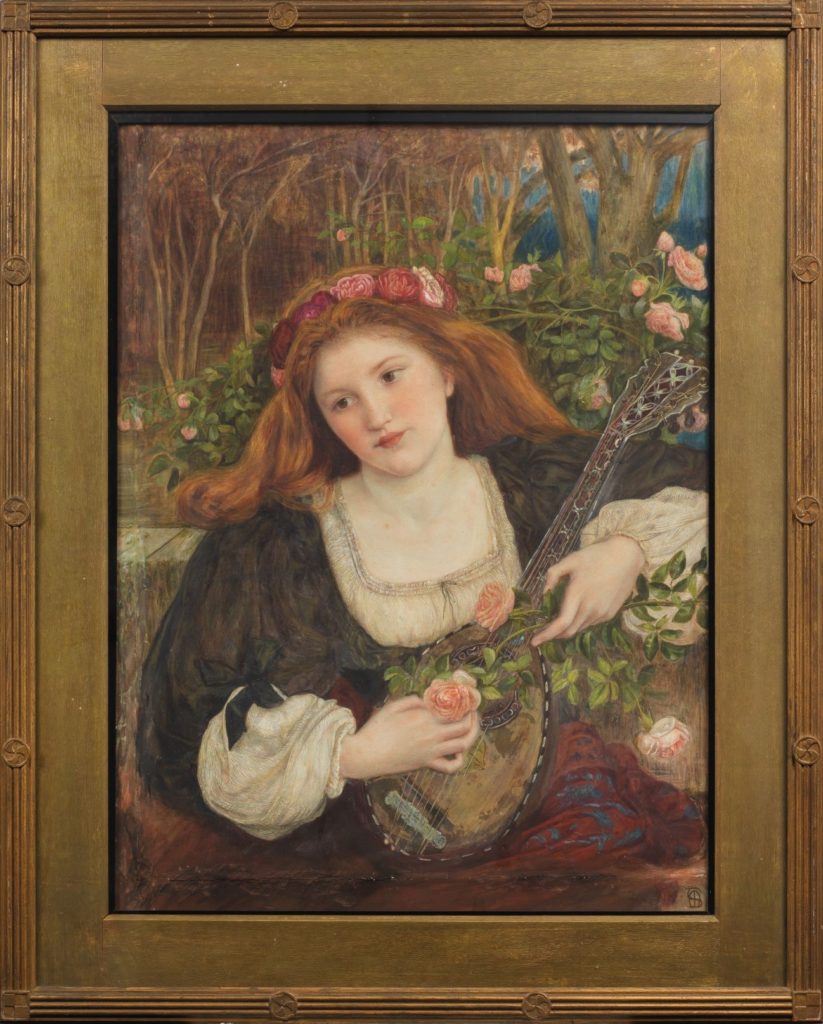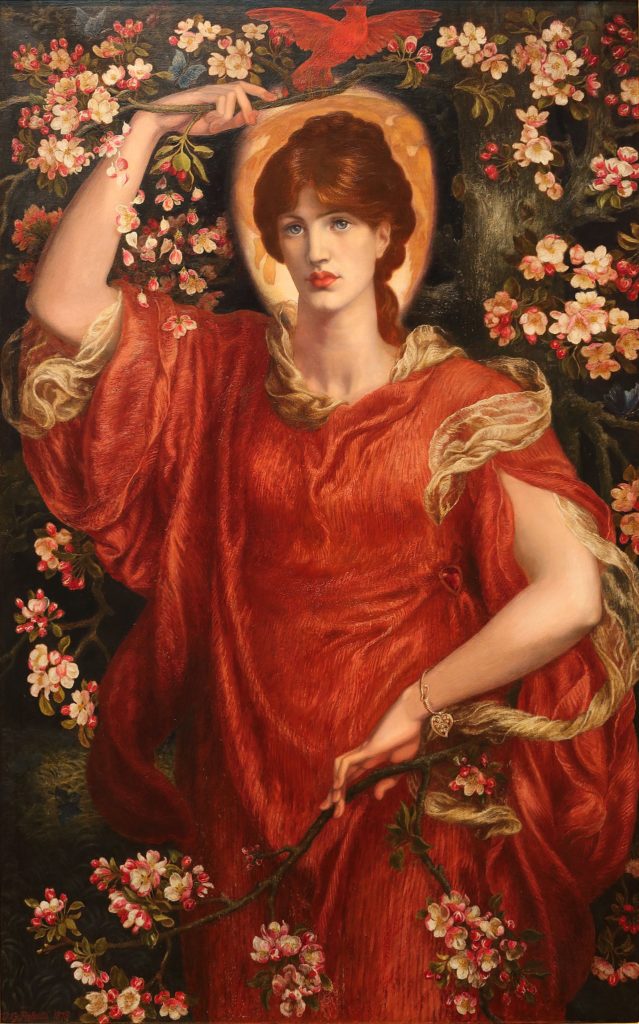Guest post by Margaretta S. Frederick, Delaware Art Museum

A Long-Lost Painting Reappears
In fall 2022 The Last Sight of Fiammetta, an important painting by the Pre-Raphaelite artist Marie Spartali Stillman (1844–1927), was offered at Bonhams, London (Fig. 1).
The painting, a key work in her career trajectory, had not been seen in public for almost 50 years. The painting was exhibited at the Royal Academy in 1876 and the Paris Exhibition Universelle in 1878. It exemplifies Spartali Stillman’s mature style, a combination of Ruskinian attention to detail and Pre-Raphaelite poetry. The subject is found in a sonnet of the same title by the Italian Renaissance poet Giovanni Boccaccio. In the poem, Boccaccio venerates his beloved, Maria D’Aquino, under the assigned name of Fiammetta. The sonnet was included in Dante Gabriel Rossetti’s compilation of poetry The Early Italian Poets, published in 1861 (reprinted in his Dante and his Circle, 1874).
Spartali Stillman’s Fiammetta depicts a seated female figure seemingly lost in reverie as she meditatively strokes the strings of a lute. She wears a circlet of roses in her brilliant red-gold hair, echoing Boccaccio’s description, “Round her red garland and her golden hair I saw a fire about Fiammetta’s head.” The rose bush from which her garland was composed creeps over the wall behind her in a thickened wave. Beyond, a dense wood effectively encloses the composition, enveloping her in an Edenic setting.
Marie Spartali Stillman’s Career Path
The accomplishments of women artists of the period have often been lost to history. The erasure of these traditional markers of success make comparison with their male counterparts difficult for present day historians. During this period, it was de rigueur for young women of the middle and upper classes to receive some form of “artistic instruction,” clouding the distinction between amateur and professional. While men were ranked by their professional training, exhibition record, critical review, and sales, many of these markers were unavailable to women.

Marie Spartali Stillman was the daughter of a wealthy Greek importer. She and her family were part of the large community of Greek expatriates living in London during the second half of the nineteenth-century. Their home on Clapham Common was tastefully furnished, reflecting the aesthetic interests of her parents and their compatriots. Artists, musicians, and writers were welcomed and were included in numerous social gatherings. It was this atmosphere that undoubtedly provoked Marie’s desire to become an artist. Despite societal restrictions for young women of her social stature, she was permitted to take lessons with Pre-Raphaelite artist Ford Madox Brown. She spent time at his studio training with his two daughters, Lucy and Catherine. She first exhibited her work in 1867 and continued to do so annually through the 1880s. In addition, she modeled for many of the artists she came to know, including Brown, Rossetti, and Edward Burne-Jones.

Her extant oeuvre is limited to approximately 100 works. Most are in private collections and/or have disappeared with the passage of time. Her reputation has suffered as so few examples of her work are in public collections. (The Delaware Art Museum holds the largest collection of her work, including Love’s Messenger (Fig. 2) and The Pilgrim Folk (Fig. 3)). Recently, however, the value of her work has risen exponentially. The Last Sight of Fiammetta was offered for £70,000–£100,000, but was knocked down at £290,100.
So why is this painting considered so important within Spartali Stillman’s oeuvre?
The Last Sight of Fiammetta was exhibited at two estimable venues, the bastion of the academic tradition, the Royal Academy, and the British section of the Paris Exhibition Universelle. Inclusion at both venues required an invitation and was highly competitive. Upon exhibition at the RA, the painting was described by William Michael Rossetti as
. . . one of the genuinely fine works of colour in the exhibition—warm, soft pure flesh tints, admirably supported by the general colour scheme, the copper-yellow hair garlanded with red and pink roses, the charmingly-painted mandolin, the embowering foliage. The face is as frank and natural as it is glowing in youthful freshness; intense also, and poetical in character.
Rossetti made these remarks despite the painting being hung in an obscure location. His mention is a mark of Spartali Stillman’s status within the professional art world. Sadly, we have no record of its sale. In fact, the painting disappeared from view shortly thereafter, until it came up for auction in 1967.
Enter Dante Gabriel Rossetti
In the case of this particular painting, there may be another indicator of achievement. In June of 1877 Rossetti first began to consider painting his own picture based on Boccaccio’s Fiammetta. Serendipitously (?), he asked Marie to sit for the composition, which would become A Vision of Fiammetta (Fig. 4).

Upon completion the painting was framed with an extensive inscription including Boccaccio’s sonnet (in Italian and Rossetti’s English translation) as well as the artist’s own poem, “Fiametta (For a Picture).”
The composition depicts a single three-quarter-length female figure clothed in a brilliant red-orange fabric. She stands amidst a bower of apple blossoms from which she is shown as if emerging. Her arms part the limbs at top and bottom of the composition as she passes through. Above her head, a red dove alludes to her passage from this world into the next, as described in Rossetti’s poem,
While from the quivering bought the bird expands
His wings. And lo! Thy spirit understands
Life shaken and shower’d and flown, and Death
drawn near
This was by no means the first time Marie had modeled for Dante Gabriel (she began in 1869). But in 1871 she had married the American painter and journalist William Stillman. Post-marriage she was less available for sittings. She was responsible for the care of Stillman’s three children from a previous marriage. In addition, the couple’s first child was born in 1872. Her agreement to model for Rossetti’s Fiammetta would be her last sitting. Shortly thereafter, in December 1877, she would depart for Turin with her new family.
Competition or complement?
Rossetti’s decision to take up his Fiammetta just over a year after the successful debut of Marie’s own interpretation of the subject is worth consideration. More significant was his choice of Marie as model. One might conclude that the whole endeavor was a bid to confront and eclipse Marie’s adaptation of a subject with which he so directly associated.
But Rossetti’s relationship with Spartali Stillman was long-standing and, as correspondence reveals, one of mutual and deep respect. Certainly, Rossetti saw himself as her mentor, often advising her on her work. During the period when she was sitting for his Fiammetta, she brought several of her paintings to his studio for review, including The Last Sight of Fiammetta. Of this he wrote,
The Fiammetta is quite complete in effect at a distance, —always a leading necessity: when near, the painting shows the difficulty there inevitably is in working water colour on so large a scale; & from this point of view I should pronounce it less satisfactory than your smaller-scale works . . . however, we can go over these points when we meet.
Mixed praise at best.
Conclusion
Spartali Stillman’s successful professional career within the paternalistic London art world was part of a larger re-definition of womanhood. This gender rebalancing was unfolding throughout her own and Rossetti’s lifetime. Rossetti’s conflicted response is apparent throughout his oeuvre. His subjects express a visual dichotomy featuring iconic women often depicted as ideal fantasies of the feminine.
The period between 1876–78, in which the two Fiammettas were painted, was a difficult one for Rossetti. His health was poor and he experienced bouts of paranoia, undoubtedly exacerbated by insomnia and heavy reliance on chloral. In addition, his diminished pictorial output caused financial worry. But in 1877 he showed modest signs of improvement. Fiammetta would be his last major composition before his death four years later.
Rossetti’s response to Spartali Stillman’s The Last Sight of Fiammetta is a true marker of her status among her peers. His reckoning with her painting through the creation of his own version suggests the level of respect she had achieved. To paraphrase a much-overused adage, inspiration is the sincerest recognition of achievement.
Margaretta S. Frederick is Curator Emerita, Bancroft Pre-Raphaelite Collection, at the Delaware Art Museum. She has written and published extensively on women in the Pre-Raphaelite circle. She is currently co-editing the letters of May Morris.
Other Art Herstory blog posts you might enjoy:
British Women Artist-Activists at The Clark Art Institute, by Erika Gaffney
A Room of Their Own: Now You See Us Exhibition at Tate Britain, by Kathryn Waters
An Introduction to Minnie Jane Hardman, by Hannah Lyons
Helen Allingham’s Country Cottages: Subverting the Stereotype, by Amy Lim
Illuminating Sarah Cole, by Kristen Marchetti
Defining Moments: Mary Cassatt and Helen McNicoll in 1913, by Julie Nash
Laura Seymour Hasbrouck, A Painter of the Hudson River School, by Lili Ott
The Rich and Complex Character of May Morris, Designer, Embroiderer, Jeweller and Writer, by Thomas Cooper
Visual Feasts: The Art of Sarah Mapps Douglass, by Erika Viola
Evelyn De Morgan: Painting Truth and Beauty, by Sarah Hardy
Portraying May Alcott Nieriker, by Julia Dabbs
Celebrating Eliza Pratt Greatorex, an Irish-American Artist, by Katherine Manthorne
The Ongoing Revival of Matilda Browne, American Impressionist, by Alexandra Kiely
Marie Laurencin and the Autonomy of Self-Representation, by Mary Creed
Victorine Meurent, More than a Model, by Drēma Drudge
The Abstract-Impressionism of Berthe Morisot and Joan Mitchell, by Paula Butterfield
Esther Pressoir: Imagining the Modern Woman, by Suzanne Scanlan
The Theatrical Wonders of Jeanne Paquin’s Belle Époque Parisienne, by Julia Westerman





Trackbacks/Pingbacks